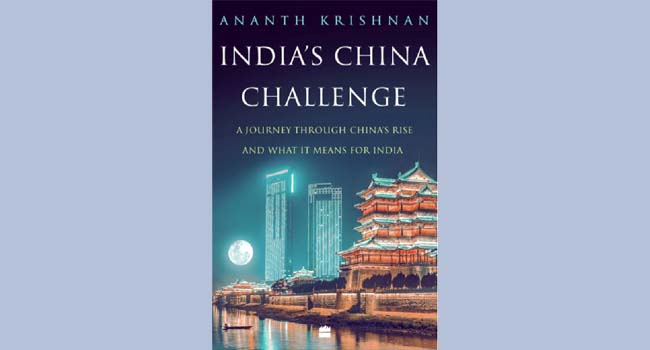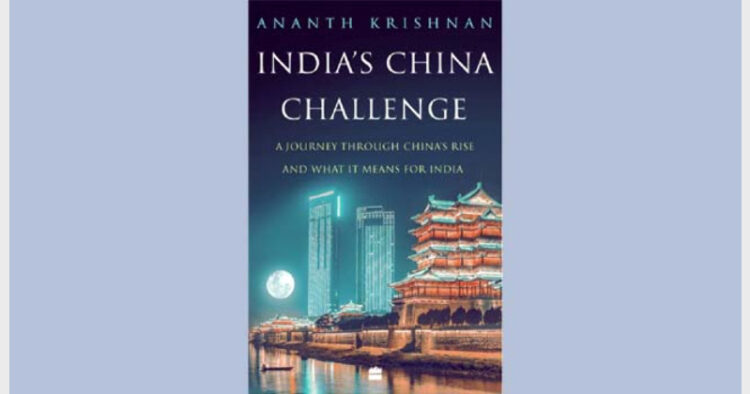It would not be a matter to say that very few books get the privilege of being published at the right time. Furthering the debate on China, Ananth’s book gives a positive boost to how the violent clash of Galwan valley has awakened the long-dormant image of China in the subconscious mind of the Indian public and policy-makers
–Pratik Kumar

Book Titles: India’s China Challenge
Author: Ananth Krishnan Publisher: Harper Collins
Rs 478/- pp. 420
Rs 478/- pp. 420
Ask any history buff in India about Chinese travellers, and most probably he/she would answer with the names of Havensang and Faxian. However, repeat these names with somebody from China, and he/she would refuse to recognise the former one for the obvious reason that it’s not his real name. Apart from indicating the quest of the Chinese to explore their neighbours and the lack of awareness on the part of Indians in even knowing the actual name of one of the most crucial historical links between these two Asian giants; it also says a lot on the prevalent strategic culture. One of the reasons behind it is that even before the establishment of modern diplomatic relations, the ideas of Indian strategic analysis have traditionally been Western-centric, and despite being of oriental culture, the ideological edge in the study of China has remained blunt. Nothing can be a better example of this than the 1962 war. The fact itself is shocking that even after being the second-largest economy in the world and possibly a neighbour of a rising military superpower, Indians know very little about the Chinese and often form their opinions from myths. This noticeable lack of curiosity about neighbouring countries and superpowers shows the shallowness inherent in the strategic culture of virtually any nation. Keeping these things in view, Anant Krishnan’s recent book “India’s China challenge” guides towards the need for the development of a new and comprehensive strategic understanding of an omnipresent behemoth- China.
It would not be a matter to say that very few books get the privilege of being published at the right time. Furthering the debate on China, Ananth’s book gives a positive boost to how the violent clash of Galwan Valley has awakened the long-dormant image of China in the subconscious mind of the Indian public and policy-makers. Several books and articles on the problematic aspects of Indo-China relations, one thing is common in all of them: that the writing of a majority of these books has been based on external observation and study. This was glaringly visible after the recent Galwan valley clash when various writers and columnists were asserting their views with little or no insider observation of China. Notwithstanding this, Anant Krishnan has shifted from this external experience-based writing tradition in his book. In different chapters, he has suitably employed his observation skills derived from his ten years of stay in China as a reporter and shown a comprehensive understanding compiled by visiting various provinces.
The “India’s China Challenge”, which is divided into six parts and a total of twenty-four chapters, draws a broad blueprint of China’s current situation and its bilateral relations with India in the contemporary geopolitical perspective. The first two parts and the fifth one, focus mainly on political history and socio-economic life in China. The remaining three interests revolve around Indo-China relations in which the writer has presented a welcome ground-based approach towards the controversial issues, issues of strategic importance and cultural depths between the two countries as.
The book presents two central themes. First, the current status of China as an emerging superpower and its internal challenges; and second, the rapidly changing dimensions of India-China relations. It is to be noted here that with a realistic eye, the Author has indicated towards the possibility that in the future, if India will govern the bilateral relations from the current status quoist approach, soon the key of its control will go solely in the hands of China.
The “India’s China Challenge”, which is divided into six parts and a total of twenty-four chapters, draws a broad blueprint of China’s current situation and its bilateral relations with India in the contemporary geopolitical perspective
While presenting the first theme, which is based on China and appears to be a cut off from the title, he has given a gripping narrative on the new developments under the undisputed leadership of Xi. However, with a note of caution, he observes that all of this is still happening in the shadow of “Red legacy” left by Mao. In tracing the difference between the period of upheaval under Maoist China to a “stable and strong” China, this book narrates the story through a parallel journey of different generations. However, like most of the mainstream books of today on the rise of China, it has not been able to effectively underline the crucial developments of Chinese society in the Deng era. In understanding the joint ‘impermeable structure” of party and state, the Author has done extensive groundwork research on which he warns in words that “while many things have changed, one should never lose sight of what has not changed.” Whether it be unearthing the state surveillance and the clouds of continuous intimidation on foreign journalists or the life of dissenters in China, Author has nicely balanced his discernible stance amid the crowd of hawks and doves on China.
In the second and main theme, the book revisits the Sino-Indian relations with a pragmatic stand. In capturing the Doklam standoff to the recent galwan clash, it doesn’t lose sight of the growing disparity between the two countries. At the same time, it recognises the pitfalls of Indian diplomacy and regional imbalances with an inevitable entry of China into the Indian diplomatic orbit. Its chapters, describing the ghosts of past and present challenges to a warm relation such as Sino-Pak nexus and border tensions show an approach guided with astuteness. The last part, which depicts six different people acting as a bridge between the shared values takes the reader back to the possibility of a shared Asia- something which is slowly getting out of sight.
At a more fundamental level, the Author has brushed up the various nuances of Sino-Indian relations with additional insight into the Chinese paradox. It makes the “India’s China challenge” a timely addition in the Indian scholarship on China where there is always a risk of immature assessment from either side. In any case, the lessons, personal views, and inherent Author’s bias subtly affect the writing, but it’s up to the readers how they take it.














Comments